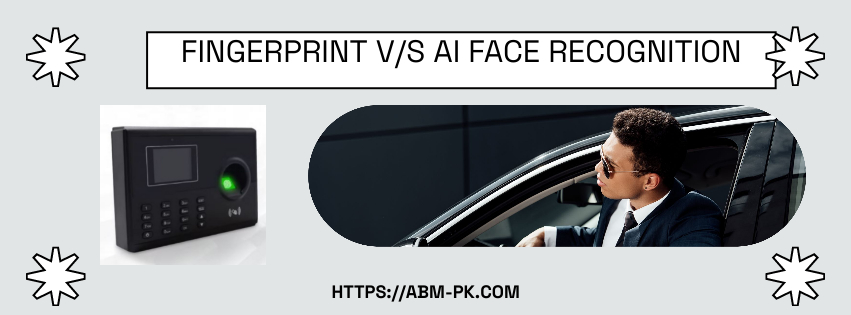Comparison for Modern Fingerprint V/S AI Face Recognition Attendance Systems
In this article we will focus on digital workplace, businesses are increasingly turning to advanced fingerprint biometric solutions to streamline their attendance tracking processes. The debate between traditional fingerprint systems and modern face recognition attendance machine technology has become more relevant than ever. Both technologies offer unique advantages, but understanding their differences can help organizations make informed decisions about which biometric attendance system face recognition solution best fits their needs.
What is a Face Recognition Attendance Machine?
ABM Innovative FZE biometric face attendance machine represents the critical control of workforce time management technology. ABM stylish devices use AI (artificial intelligence) processes to identify employees by analyzing unique facial topographies. Unlike most of security methods, ABM face scanner machine can process simultaneously many individuals in a long queue, making it ideal for high-traffic worker surroundings.

Understanding Face Recognition Technology
Modern face recognition time attendance systems have evolved significantly, offering seamless integration with existing HR software. The technology behind each biometric device face recognition has become increasingly sophisticated, capable of working in various lighting conditions and even recognizing faces with minor changes in appearance.
Mobile Integration and Face Recognition Accessibility
The ABM Innovative FZE integration of Mobile App face scan attendance machine technology has transformed how employees interrelate with time attendance systems. Workers can now clock in and out using their smartphones, providing flexibility for remote work arrangements or field-based positions. This mobile capability extends the reach of traditional face scanner attendance system solutions beyond physical office locations.
The Traditional Fingerprint Approach v/s Face Recognition Hybrid Systems
Many organizations are exploring fingerprint and face recognition hybrid solutions that combine the reliability of fingerprint scanning with the convenience of facial recognition. These face fingerprint attendance machine systems offer multiple verification methods, allowing employees to choose their preferred authentication method while maintaining security standards.
Comprehensive Attendance Face Recognition Systems Building an Integrated Solution
A complete attendance face recognition system goes beyond simple identification. These comprehensive platforms integrate with payroll systems, generate detailed reports, and provide real-time monitoring capabilities. The face recognition and attendance system architecture typically includes cloud-based storage, mobile applications, and administrative dashboards.
Finding the Right Biometric Supplier
When searching for a Near Me face detection machine Supplier, organizations should consider factors such as technical support, installation services, and ongoing maintenance. A reliable supplier will offer comprehensive training on their face detection attendance machine and provide regular software updates to maintain security standards.
Technical Advantages of Face Recognition Speed and Convenience
The main benefit of an ABM attendance face machine fabrication rely on its fast speed and contactless quick operation. Employees can authenticate their identity in seconds without physical contact, which has become particularly important in health-conscious work environments. The face biometric attendance machine eliminates concerns about hygiene while maintaining accuracy.
Face Recognition Scalability and Management
Modern face scanner attendance system solutions can handle thousands of employees across multiple locations. The centralized management capabilities allow HR departments to monitor attendance patterns, generate reports, and manage employee data from a single platform.
Comparing Accuracy and Security Face Recognition Reliability
Today’s biometric face attendance machine technology boasts impressive accuracy rates, often exceeding 99% in controlled environments. The advanced algorithms can distinguish between identical twins and detect attempts at spoofing using photographs or videos.
Fingerprint System Strengths
Traditional fingerprint systems remain highly reliable, particularly in environments where facial recognition might be challenging due to lighting conditions or facial coverings. However, fingerprint and face recognition combination systems offer the best of both worlds.
Implementation Considerations of Biometric Cost Analysis
When evaluating face recognition time attendance solutions, organizations must consider both initial hardware costs and ongoing operational expenses. While a biometric device face recognition system may have higher upfront costs, the long-term benefits often justify the investment through reduced administrative overhead and improved accuracy.
Employee Attendance Acceptance
The transition to a Mobile App face scan attendance machine often receives positive feedback from employees who appreciate the convenience and modern technology. However, organizations should provide adequate training and address any privacy concerns during implementation.

Industry Applications Diverse Sector Adoption
From manufacturing facilities to corporate offices, attendance face recognition system technology has found applications across various industries. Educational institutions, healthcare facilities, and retail environments have all benefited from implementing face recognition and attendance system solutions.
Modern face biometric attendance machine systems offer extensive customization options to meet specific industry requirements. Whether it’s integration with existing security systems or compliance with industry regulations, these solutions can be tailored accordingly.
Future Trends and Developments Emerging Technologies
The evolution of face scanner machine technology continues with improvements in artificial intelligence and machine learning. Future biometric attendance system face recognition solutions will likely incorporate additional biometric factors and enhanced security features.
Integration Capabilities Fingerprint V/S AI face recognition
Next-generation face fingerprint attendance machine systems will offer even greater integration capabilities with cloud-based HR platforms, IoT devices, and smart building management systems.
Making the Right Choice Face Machine Evaluation Criteria
When selecting between fingerprint and face recognition solutions, organizations should consider factors such as employee count, work environment, budget constraints, and long-term scalability needs. A thorough evaluation of available Near Me face detection machine Supplier options can help identify the most suitable solution.
Implementation Best Practices of Fingerprint V/S AI face recognition
Successful deployment of any face detection attendance machine requires careful planning, employee training, and ongoing support. Organizations should work closely with their chosen supplier to ensure smooth implementation and optimal performance.

Most common FAQ:
Q: What is biometric authentication?
A: These “biometric authentication traits” are unique to each employee and are tough to replicate, making them a strong form of workers identity verification.
Q: Why are biometrics considered more secure than passwords or PINs?
A: Unlike passwords or PINs, which can be forgotten, stolen, or guessed, biometric data is inherently tied to an individual. It’s much harder to forge or falsify a fingerprint or a live facial scan, significantly reducing the chances of impersonation or fraud.
Q: Can biometric systems be hacked?
A: While no system is completely foolproof, biometric systems are designed with various security measures to protect against threats. However, like any digital system, they can be vulnerable to sophisticated spoofing techniques or data breaches if not properly secured. Strong encryption and multi-factor authentication (MFA) are crucial.
Q: What are the main privacy concerns with biometric technologies?
A: A significant concern is the collection, storage, and potential misuse of sensitive biometric data. If compromised, this data is difficult to change, unlike a password. Regulations (like GDPR) and ethical guidelines are essential to govern how this data is handled, stored, and used.
Q: How does fingerprint recognition work?
A: A fingerprint scanner captures an image of your fingertip. The system then extracts unique features like ridge endings, bifurcations (where a ridge splits), and the overall pattern. ABM face recognition features are transformed into a visual numeral pattern (a mathematical values illustration) and stored. For proof, a new scan is compared to the stored database template.
Q: What are the advantages of fingerprint recognition?
A: High Accuracy: Generally very accurate, especially with good quality sensors.
Cost-Effective: Hardware for fingerprint scanning tends to be more affordable and widely adopted.
Established Technology: Has a long history of use and is well-understood.
User-Friendly: Simple and intuitive to use, requiring a quick touch.
Reliable: Fingerprints are generally stable over time.
Q: What are the disadvantages of fingerprint recognition?
A: Requires Physical Contact: Can be less hygienic and inconvenient if hands are dirty, wet, or injured.
Susceptibility to Spoofing: While difficult, high-quality replicas of fingerprints can potentially deceive some scanners.
Environmental Factors: Performance can be affected by dirt, moisture, or damage to the finger.
Less Versatile: Not ideal for remote or touchless applications.
Q: In what scenarios is fingerprint recognition commonly used?
A: Fingerprint recognition is widely used for smartphone unlocking, access control in offices, time and attendance tracking, and identity verification in various consumer and enterprise devices.
Q: How does AI face recognition work?
A: ABM AI face recognition uses dual high resolution HD cameras to capture a visual image or short video of a person’s face. Advanced AI algorithms (often deep learning) analyze unique facial features such as the distance between eyes, shape of the nose, and jawline. A “facial map” or alphanumeric prototype is created and then compared against stored records to verify identity.
Q: What are the advantages of AI face recognition?
A: Contactless and Hygienic: No physical interaction required, making it ideal for high-traffic areas, public spaces, and situations prioritizing hygiene (e.g., during pandemics).
Convenience and Speed: Allows for quick and seamless identification, often without users needing to pause or consciously interact.
Scalability: Can process large crowds rapidly, useful for monitoring and crowd control.
Adaptability: Advanced systems can perform well in various lighting conditions and with minor changes in appearance (e.g., glasses, some facial hair).
Enhanced Security (with Liveness Detection): Modern systems include “liveness detection” to prevent spoofing with photos or masks.
Q: What are the disadvantages of AI face recognition?
A: Privacy Concerns: Raises significant concerns about mass surveillance, tracking, and potential misuse of personal data without consent.
Accuracy Issues: Can be less accurate in poor lighting, extreme angles, or with significant facial obstructions (e.g., masks, heavy makeup).
Bias: Some algorithms have shown biases in accuracy across different demographics (e.g., race, gender, age) if not trained on diverse datasets.
Cost: Often requires higher-end cameras and more advanced software, leading to higher initial implementation costs.
Susceptibility to Spoofing (without Liveness Detection): Older or less sophisticated systems can be fooled by photos or videos.
Challenges with Identical Twins: Can struggle to differentiate between identical twins due to highly similar facial features.
Q: In what scenarios is AI face recognition commonly used?
A: AI face recognition is increasingly used for smartphone unlocking (e.g., Face ID), security in airports and public spaces, access control, smart home systems, retail security, and even payment systems.

Conclusion
The prime feature between ABM-81 fingerprint and ABM-K-6 AI face recognition systems eventually depends on precise structural needs and preferences. While traditional fingerprint systems offer proven reliability, modern attendance face machine technology provides enhanced convenience and scalability. Many organizations find that hybrid fingerprint and face recognition access control Dubai solutions offer the perfect balance of security, convenience, and flexibility.

As technology continues to evolve, the gap between these two approaches may narrow further, with both systems offering increasingly sophisticated features. The key is to evaluate current needs while considering future growth and technological advancements to make an informed decision that will serve the organization well for years to come.


Pingback: Cloud biometric and cyber attack
Pingback: Biometric Attendance Machine Supplier Cheap Price